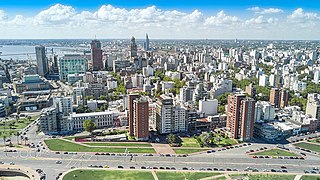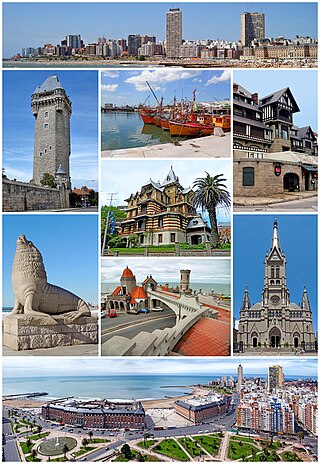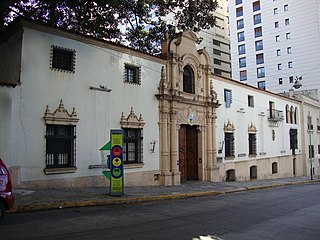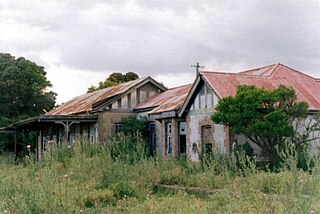
The Juan Carlos Castagnino Municipal Museum of Art is a museum of fine arts in Mar del Plata, Argentina. Its building, the Ortiz Basualdo Villa, is a National Monument of Argentina. [1]

The Juan Carlos Castagnino Municipal Museum of Art is a museum of fine arts in Mar del Plata, Argentina. Its building, the Ortiz Basualdo Villa, is a National Monument of Argentina. [1]
Commissioned by the Ortíz Basualdo family of Buenos Aires, the villa on Mar del Plata's Stella Maris Hill was built in 1909 as a summer residence. Designed by Luis Dubois and Pablo Pater, the eclecticist, the Art Nouveau villa followed a picturesque movement in French architecture common to new, upscale residences in both France and Argentina, at the time (the exterior's half-timber motif, accordingly, was painted on). The structure, predominantly in stone, was capped by zinc mansard roofing. [2]
The oceanfront city was given its first municipal museum of fine art in 1938, when the facility was inaugurated in the Mar del Plata City Hall. The museum gathered a collection of mainly modern art in subsequent decades, and in particular works by local realist painter and muralist Juan Carlos Castagnino. [3]
The donation of the villa by the Ortíz Basualdo family resulted in the museum's relocation, and the institution was re-inaugurated therein on July 9, 1980. The family's donation included a large selection of furniture acquired between 1909 and the villa's remodel in 1918. The collection, designed by Belgian architect and cabinetmaker Gustave Serrurier-Bovy, is widely considered among the world's finest of its type, and was incorporated into the museum's exhibits. [3]
The museum's collections feature nearly 600 paintings, sculptures, lithographs, photographs and other works, including those by Argentine artists Antonio Berni, Alberto Bruzzone, Prilidiano Pueyrredón, Luis Seoane, Raúl Soldi, and Juan Carlos Castagnino, for whom the museum was renamed in 1982, and of whom the museum houses 138 works. [2]
Across the street from the Mar del Plata Museum of the Sea, the villa, an exhibit in itself, was declared Cultural Heritage of the City of Mar del Plata in 1995. [2]
In December 2020, the Ortiz Basualdo Villa was declared National Monument of Argentina. [1]

Montevideo is the capital and largest city of Uruguay. According to the 2011 census, the city proper has a population of 1,319,108 in an area of 201 square kilometers (78 sq mi). Montevideo is situated on the southern coast of the country, on the northeastern bank of the Río de la Plata.

Mar del Plata is a city on the coast of the Atlantic Ocean, in Buenos Aires Province, Argentina. It is the seat of General Pueyrredón district. Mar del Plata is the second largest city in Buenos Aires Province. The name "Mar del Plata" is short for "Mar del Rio de la Plata," and means "sea of the Rio de la Plata basin" or "adjoining sea to the (River) Plate region." Mar del Plata is one of the major fishing ports and the biggest seaside beach resort in Argentina. With a population of 682,605 as per the 2022 census [INDEC], it is the 5th largest city in Argentina.

La Plata is the capital city of Buenos Aires province, Argentina. According to the 2022 census, the Partido has a population of 772,618 and its metropolitan area, the Greater La Plata, has 938,287 inhabitants. It is located 9 kilometers inland from the southern shore of the Río de la Plata estuary.

Recoleta is a barrio or neighborhood of Buenos Aires, Argentina, located in the northern part of the city, by the Río de la Plata. The area is perhaps best known to be the home of the distinguished Recoleta Cemetery. It is a traditional upper-class and conservative neighborhood with some of the priciest real estate in the city, known for Paris-style townhouses, lavish former palaces and posh boutiques.

The following is an alphabetical list of topics related to the Argentina.

The Juan B. Castagnino Fine Arts Museum is an art museum in the city of Rosario, province of Santa Fe, Argentina, considered the most important of the interior of the country and the second in national terms. It is administered by the municipal government. The museum lies within the Parque de la Independencia immediately outside the city center, at the intersection of Oroño Boulevard and Pellegrini Avenue.

The National Historical Museum is a museum located in Buenos Aires, Argentina, and is a museum dedicated to the history of Argentina, exhibiting objects relating to the May Revolution and the Argentine War of Independence.

Juan Carlos Castagnino was an Argentine painter, architect, muralist and sketch artist.
There are many landmarks in Buenos Aires, Argentina, some of which are of considerable historical or artistic interest.

The La Plata Museum is a natural history museum in La Plata, Argentina. It is part of the Facultad de Ciencias Naturales y Museo of the National University of La Plata.

The Museum of the Sea was a museum of marine biology and aquarium in the seaside city of Mar del Plata, Argentina. The museum closed its doors in September 2012, after 12 years in operation.
Museum of Fine Art may refer to:

The Eduardo Sívori Museum of Plastic Arts is a municipal art museum in Buenos Aires, Argentina. It was named after painter Eduardo Sívori and was inaugurated in 1938.

Manuel Espinosa was an Argentinian painter.

The Museo de Arte Hispanoamericano Isaac Fernández Blanco is a museum of art located in the Retiro ward of Buenos Aires, Argentina.

Luis Perlotti was an Argentine sculptor.

Alberto Nicasio was an Argentine artist (xylographer) and educator. He was a member of the Argentinian National Academy of Arts. A street in the city of Córdoba and a primary school in the province are named after him.
Silvia Rivas is an Argentine visual artist known for her multi-channel video installations. In Latin America she is considered a precursor in the area of expanded video. Her work is characterized by the crossing of materialities and technologies in which she uses both electronic devices and ancestral techniques. Her production is organized in thematic series of video installations, drawings, photographs or objects. Interested in revealing the metaphorical power of different materialities, she uses the electronic medium and the moving image to record stillness, the imminent and the subjective perception of time.

Juancho is a former railway station and current museum located in the General Madariaga Partido of Buenos Aires Province. The station was originally built by British-owned Buenos Aires Great Southern Railway in 1908, helping tourists reach the cities on the Atlantic coast such as Ostende, the first town established in region currently known as Pinamar Partido, and then Villa Gesell.